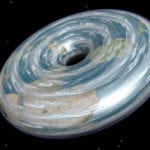 Mysteries
Mysteries  Mysteries
Mysteries  History
History 10 Surprising Stories About the Texas Rangers
 Humans
Humans 10 Philosophers Who Were Driven Mad by Their Own Theories
 Miscellaneous
Miscellaneous 10 Video-Game-Worthy Weapons and Armors from History
 Weird Stuff
Weird Stuff 10 Psychics Who Accurately Predicted Wartime Events
 The Arts
The Arts 10 Pieces of Art Inspired by a Broken Heart
 Health
Health 10 Science Fiction-Sounding New Medical Treatments
 History
History 10 Surprising Facts About the Father of Submarine Warfare
 Space
Space Ten Astonishing New Insights into Alien Worlds
 Weird Stuff
Weird Stuff 10 Bizarre Summer Solstice Rituals Still Practiced Today
 Mysteries
Mysteries Top 10 Haunting Facts About the Ghost Ship MV Alta
 History
History 10 Surprising Stories About the Texas Rangers
 Humans
Humans 10 Philosophers Who Were Driven Mad by Their Own Theories
Who's Behind Listverse?

Jamie Frater
Head Editor
Jamie founded Listverse due to an insatiable desire to share fascinating, obscure, and bizarre facts. He has been a guest speaker on numerous national radio and television stations and is a five time published author.
More About Us Miscellaneous
Miscellaneous 10 Video-Game-Worthy Weapons and Armors from History
 Weird Stuff
Weird Stuff 10 Psychics Who Accurately Predicted Wartime Events
 The Arts
The Arts 10 Pieces of Art Inspired by a Broken Heart
 Health
Health 10 Science Fiction-Sounding New Medical Treatments
 History
History 10 Surprising Facts About the Father of Submarine Warfare
 Space
Space Ten Astonishing New Insights into Alien Worlds
 Weird Stuff
Weird Stuff 10 Bizarre Summer Solstice Rituals Still Practiced Today
10 Animals with Interesting Digestive Systems
Evolution has produced some weird, wonderful, and downright disgusting ways of digesting food. While certain species’ digestive systems are fascinating because of their strangeness, others provide some valuable lessons for humans—and could even reveal the secret to generating planet-friendly fuel sources. From stomach-ejecting sea creatures to rock-swallowing birds, let’s explore ten of the most interesting digestive systems in the animal kingdom.
Related: 10 Impressive Examples Of Animal Self-medication
10 Pufferfish
The pufferfish’s inflating stomach is one of nature’s more unusual evolutionary quirks. These aquatic creatures can rapidly fill their stomachs with saltwater when threatened, instantly tripling their size until they look like spiky balloons. This ability is handy when you don’t have the swimming ability to escape predators, but it raises a conundrum—how do pufferfish digest food?
Pufferfish evolved to puff up by losing one of the sphincters responsible for holding food and gastric acids within the stomach. Losing a sphincter is ideal for rapid stomach inflation, but it also prevents the stomach from digesting meals. In other words, the stomachs of pufferfish have changed function, switching from digestive organs to defensive mechanisms.
However, the rest of the fish’s digestive system has adapted to compensate. The intestines and rectum secrete acids, essentially standing in as a substitute stomach.[1]
9 Swell Sharks
Speaking of animals that can puff up at will, the swell shark is another aquatic creature with an incredibly expanding stomach. Unlike its more dangerous relatives, swell sharks are a relatively docile species living mainly in shallow waters in the Pacific Ocean. When under attack, these sharks quickly swallow large amounts of water, doubling their size and giving themselves a bizarre, alien-like appearance. However, this mechanism doesn’t just make them look peculiar—by curving and puffing their bodies, swell sharks make it much harder for predators to inflict a fatal bite.
Unlike pufferfish, swell sharks have functioning stomachs. Patrícia Ferreira, a Ph.D. student at the Canadian Wilfrid Laurier University, discovered that these sharks produce gastric acid. Additionally, she noted that the pH levels inside a swell shark’s stomach reduce when they puff up, proving that saltwater can impact acidity levels. A recently puffed shark may find it harder to digest food, but its stomach probably resumes normal function after a short period.
So, why do some species with stomach-puffing abilities have functioning stomachs while others don’t? The answer probably lies in how often the animal expands its stomach to ward off foes. Ferreira theorizes that pufferfish puff up significantly more frequently than other swelling species like swell sharks, making the loss of stomach function a worthwhile sacrifice.[2]
8 Platypus
The platypus is such a weird creature that scientists initially believed it was a hoax. Although this bizarre animal is actually a mammal, it lays eggs and has a bill like a bird. It even produces milk for its young despite its lack of nipples by secreting it through its skin. Perhaps unsurprisingly, the platypus’s weirdness extends to its digestive system.
Unlike most vertebrates, the platypus has no stomach. Instead, its gullet links straight to its intestines. Scientists are uncertain why the platypus and its closest relative, the echidna, evolved to shed an essential part of most mammalian digestive systems. Genome research shows that the platypus has also lost genes responsible for forming pepsinogen, a digestive enzyme produced by the stomach. Nobody knows precisely why the species evolved this way. However, it’s thought that changes to the diet of the platypus’s ancestors made pepsinogen unnecessary.[3]
7 Sacculina Barnacles
If you thought zombies were the stuff of horror movies, you’ve never met the sacculina barnacle. These slug-like puppet master parasites attach themselves to crabs, spreading finger-like rootlets throughout the hapless creatures’ bodies to leech nutrients and consume them from the inside out. It’s unclear how the barnacles transport nutrients from their rootlets to the rest of their bodies, but it’s thought that the rootlet membranes can convert carbohydrates into fats.
Somewhat creepily, these barnacles attach themselves to a space generally reserved for eggs on a female crab’s abdomen. The crab devotes its attention to caring for its parasitic passenger, flushing it with salt water like its own eggs. Meanwhile, male crabs experience endocrine changes that make them infertile, causing them to start nurturing the barnacle. In both cases, the crab continues to scavage for food yet cannot grow or digest its meals as it supplies a steady flow of nutrients to its parasite.[4]
6 Sea Cucumber
It may not be the most exciting-looking creature, but the humble sea cucumber has an explosive secret—it can eviscerate itself to fend off attacks. When it feels threatened, it hurls its digestive system from its anus or mouth, depending on the species. This covers the predator in entrails and leaves it confused enough for the sea cucumber to escape.
However, self-evisceration doesn’t mean certain death for the sea cucumber. Sea cucumbers can absorb oxygen and organic compounds via respiratory systems connected to their anuses. These compounds allow the creature to survive while it works on regenerating its digestive system. The sea cucumber then starts growing regenerative tissue at both ends of the digestive tract until they eventually join to form a new tube.[5]
5 Ostriches
Ostriches compensate for their lack of teeth by swallowing sharp stones and grit. These pebbles are called gastroliths, and the ostrich keeps them in its gizzard to help break up food and make it easier to digest. The gizzard is a muscular part of the stomach that squeezes the gastroliths and food together, rather like a sink garbage disposal unit. When the stones become smooth, the ostrich simply vomits them up and replaces them with new ones.
So far, so normal. Ostriches aren’t unusual in harnessing gastroliths to aid digestion—chickens, penguins, and a few non-bird species do the same thing. However, the volume of gastroliths in a typical ostrich’s stomach is pretty impressive. Gastroliths can make up to half of an ostrich’s stomach contents, and these stones account for around 1% of the bird’s total body weight. Considering an adult ostrich can weigh up to 320 pounds (145 kilograms), the largest specimens can carry over 3 pounds (1.4 kilograms) of stones in their stomachs.[6]
4 Termites
Finding termites in your garden is rarely a welcome discovery, but recent research on termite digestion could cast these roach-like critters in a new light. Falk Warneke, a member of the U.S. Department of Energy’s Joint Genome Institute’s research team, made waves in the scientific community in 2008 for his work exploring how termites convert cellulose into energy.
Termite guts are home to unique microbe colonies, allowing the insects to break apart tough cellulose to produce ethanol. Scientists can mimic this process in the lab, but creating the enzymes required is hugely costly. Researchers like Warneke hope that using enzymes from termites could one day pave the way for converting plants into eco-friendly biofuels.[7]
3 Starfish
If you’re a starfish, every mealtime starts with extending your stomach out of your mouth. Once it’s out, the stomach engulfs any edible parts of the prey, inserting itself inside shells if necessary. Finally, the stomach retracts inside the mouth, taking the soup-like, semi-digested food with it.
So far, so strange. In an even weirder twist, it turns out that the hormone crucial for sexual reproduction in humans triggers feeding behavior in starfish. Researchers from Queen Mary University of London discovered that injecting starfish with oxytocin, also known as the “love hormone,” caused them to eject their stomachs. This knowledge could allow scientists to develop methods to prevent starfish from overfeeding on endangered coral.[8]
2 Hagfish
When your primary source of nutrition is burying yourself in dead animals, absorbing nutrients through your skin can be pretty useful. Enter the hagfish: a primitive, tube-shaped fish that scavenges for food on the ocean floor. There’s nothing cute about a hagfish, but it’s an impressive example of an animal’s digestive system evolving to suit its feeding habits perfectly.
Scientists have long theorized that hagfish might be able to take in nutrients through their gills. Researchers confirmed this hunch in 2011, discovering that hagfish can absorb amino acids via the skin and gills alongside their internal digestive systems. This makes hagfish unique among vertebrates and seems logical, considering how they eat. When food is scarce, and there’s stiff competition for a meal, increasing the surface area available makes it easier to get the nutrients needed for survival.[9]
1 Lithoredo abatanica
The Litoredo abantanica is a newly-discovered form of shipworm—so new, in fact, that scientists are still figuring out the mysteries of its eating habits. All other shipworms eat wood, and there’s hope that their cellulose-digesting abilities could yield the answer to creating biofuels. Lithoredo abatanica, meaning “rock shipworm from the Abatan River,” is unique because it uses its shovel-like shell to bore through rock.
These rock-eating, wormlike clams were discovered in the Philippines in 2018. Nobody knows why they munch on rocks, and whether they gain nutrition from the activity is unclear. However, they perform a vital function in the river ecosystem, creating holes up to two feet deep that provide homes for numerous species.[10]
Since there are more animals with strange digestive traits, this list deserves a few bonuses!
+ Bonus #1: Barn Owls
Digesting live prey can be challenging when you don’t have teeth to grind food into smaller particles. Thanks to their specially-adapted gizzards, barn owls get around this problem by producing pellets.
Most of the time, barn owls swallow small prey whole. The prey then travels into the gizzard, where small stones and sand help grind it into digestible pieces. However, the gizzard and the owl’s digestive secretions can’t handle fur, bones, and other tough materials. Instead, the gizzard squeezes the undigestible parts of the prey into a pellet, which the owl then coughs up.[11]
+ Bonus #2: Pandas
Habitat loss has placed the giant panda at risk of extinction, and its unusual digestive system is hardly helping matters. Unlike other bear species, pandas eat an entirely herbivorous diet, chomping down almost exclusively on bamboo. Given that pandas evolved to prefer a herbivorous diet over two million years ago, you might assume their digestive systems would follow suit. You’d be wrong.
A 2015 study by the Chengdu Research Base of Giant Panda Breeding discovered that panda gut bacteria is better suited for a carnivorous diet, making a menu of hard-to-digest bamboo less than ideal. While the creatures no longer have the “umami” taste receptors that drive other bears to eat meat, they still have the digestive systems of carnivores. This discovery reveals why pandas spend so much time eating and could even explain their laid-back approach to reproduction.[12]








